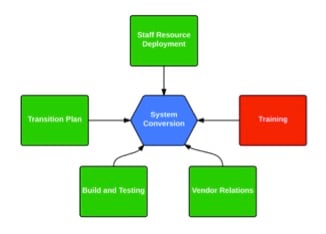In the white paper entitled Healthcare System Conversions – Key Points To Consider, we outlined three types of conversions (System Upgrade, New Platform/Same Vendor, and New Platform/New Vendor) and five points to consider when planning for a system conversion.
This article reviews the points to consider for Training for each type of conversion. Your organization must clearly define the resources needed to be assigned to the conversion or upgrade project. All three types of conversions have similar training requirements, but there are specific points to consider for each type of conversion.

Training

Often a weak point with system upgrades. The stakeholders need to clearly understand the content and impact of the upgrade on your system and organization.
- Builder/Tester Training
- Train the testers on the content of the upgrade and the expected outcomes of the enhancement/break-fix
- Sources of information include upgrade documentation from the vendor plus insight from the vendor consultant (hold them accountable for this information).
- Train the testers on the content of the upgrade and the expected outcomes of the enhancement/break-fix
- End User
- Define methodology will be used to train the end users. Options include:
- Tip Sheets – Documented tip sheets outlining the impact of the upgrade. Distribute the tip sheet through clinical leadership to review with the respective staff members (great agenda item for the staff meeting).
- Computer-based training modules or web-enabled training
- Effective tool with an upgrade. The training encompasses a review of the look of the application, functionality, and workflow changes.
- Measure and document competency on the system for all users.
- Define methodology will be used to train the end users. Options include:
New Platform/Same Vendor or New Vendor


Training is a critical requirement for conversion to a new platform, whether it is with a current vendor or new vendor. At times, the training plan is not clearly defined with conversion projects. Many times it is left up to the hospital to develop and execute the training. Here are some factors to consider:
- Format of training (initial training on the new application/platform)
- Vendor-led training
- On-site at client hospital
- On-site at vendor
- “Live” web-based training
- Computer-based training modules
- Train the Trainer
- Vendor lead “Train the Trainer” program for select hospital employees responsible for training the hospital team.
- Vendor-led training
- Hospital Staff training
- Define “who” gets the initial training from the vendor
- Ensure there is a cross-section of users and analysts selected for the training. This includes pharmacists, nurses, therapists, lab, IT analysts, IT leadership, physicians, and quality/compliance. These “super-users” become the core build team and/or upgrade team.
- Define the roll out of the training to the end users
- Classroom learning – taught by vendor or a hospital employee who completed a “Train the Trainer” program from the vendor.
- Computer based training
- Measure and document competence on the system for all users
- Upon completion of the training, document that the user has completed the training including requisite competency testing as appropriate. Many hospitals will not give a user login credentials until the user demonstrates completion of the training.
- Define “who” gets the initial training from the vendor
- Builder/Tester Training
- Train the builders/testers to the level of “super user.” This is the time to enroll end users in the training/building/testing. This improves adoption and advocacy for the new application/platform.
- End User
- Define methodology will be used to train the end users. Options include:
- Classroom training by functional group (pharmacists, nurses, physicians, therapists, lab, ancillary departments)
- Tip Sheets – Documented tip sheets outlining pointers to system use. Distribute the tip sheet through clinical leadership to review with the respective staff members (great agenda item for the staff meeting).
- Computer-based training modules or web-enabled training
- Measure and document competency on the system for all users. As mentioned above, some hospitals require the user to be “signed off” on the training before access to the new system is granted.
- Define methodology will be used to train the end users. Options include:
CLICK HERE to schedule an appointment to discuss your needs with HealthcareIS.


Comments